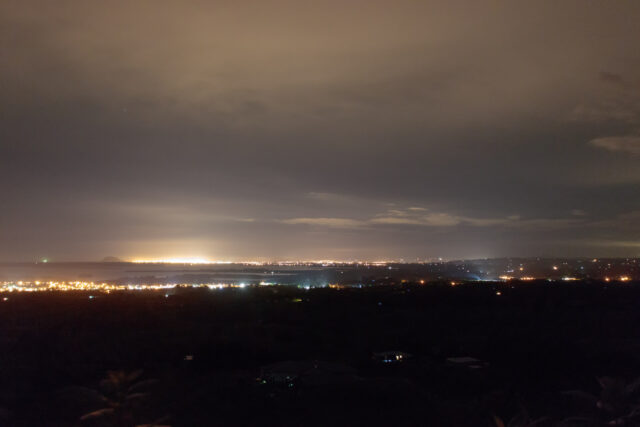Light pollution is defined as the inappropriate or excessive use of artificial light at night, and it is the fastest growing pollutant on the planet. Whilst astronomers lament the loss of stars, preventing over 80% of the world’s population from access to a natural sky, light pollution’s impacts are far more reaching. At the same time, it is also the easiest pollutant to address.
Light pollution negatively impacts on wildlife, which, much like humans, rely on the cycle of night and day to determine the timing of their biological activity. Studies have shown these impacts to include everything from wide-ranging effects on species physiology; seasonal disruptions; rate and timing of reproduction; alteration of daily activity patterns; and changes to species populations. These impacts are occurring under a range of lighting intensities, including very low lighting levels below 1 lux, and the consequences can be long-term and, in some cases, irreversible.
Light pollution by its very nature is also wasted energy, adding significant amounts of greenhouse gas emissions to our planet. There are also associated implications in the disruption of the human circadian system and our health. Without question, the outdoor lighting that once defined human progress has now become a serious human and environmental problem.
Light hasn’t historically been considered as a pollutant, but the weight of scientific evidence in recent years is now overwhelming. Indeed, there is sufficient demonstrated risk to both people and the environment that we must now adopt the ‘precautionary principle’, which places the burden of proof on those supplying, designing, installing and managing lighting to demonstrate that their products and lighting installations are not harmful. The importance of committing to environmentally sensitive design has never been more important.
To be clear, this is not just a story about street lighting. There are many other forms of public lighting that are contributing to the global light pollution problem. These include lighting from sports fields, advertising signage, media screens, facade lighting, public space lighting, not to mention the vast amounts of spill light that escapes from practically unoccupied commercial buildings on a nightly basis. It is little wonder that light pollution is increasing at a global rate of over 2% per annum.

So, with light pollution rapidly growing, and all the environmental and social repercussions it elicits, it stands to reason that there must be a really strong justification that allows this to occur? Sadly, the answer is no.
Much of the over-lighting and wastage that occurs with outdoor lighting results from for the simple fact that many lighting engineers fail to prioritise the very reason we have outdoor lighting in the first place – humans. The advancements of energy efficient technologies have placed a high emphasis on factors such as energy efficiency, cost, and lifetime maintenance. Whilst these are important factors to consider in the hierarchy of decision making, they should only be considered after the needs of the user have been addressed.
This human-centred approach to design forces us to consider questions such as where do we need light? When will we need the light, and does this change across the course of an evening? How do we want pedestrians to feel when they walk down the streets at night? In answering these questions, designers are propelled toward less glary luminaires, to warmer light sources that are more in tune with our biological systems, to employ adaptive lighting controls that respond to human use of space, and to luminaires that are site-specific to direct light to only where it is needed. And, as you have probably guessed, these are some of the very strategies that can directly help to reduce our light pollution footprint.
The benefits to this human-centred approach are far reaching. Prioritising people at the core of lighting design helps to promote night time activity; feeding night time economies and improving the safety of our towns and the health of citizens in turn. We are fortunate that the very principles that make our cities and towns more liveable after dark are the same principles that help us to reduce light pollution. In this sense, addressing light pollution is the true definition of a win-win.
Landon Bannister is a lighting advisor, Director of Southern Lighting & Distribution and Board Member of the Australasian Dark Sky Alliance. He will be a featured speaker at the Street Lighting & Smart Controls Forum on 4 May 2022 at IPWEA’s International Public Works Conference in Adelaide. Click here to register.














